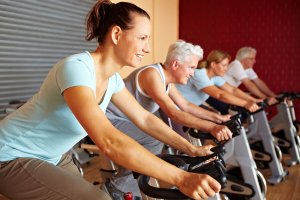Tips to Measure and Control your Heart Rate

Making the decision to measure and control your heart rate can be fundamental to maintaining your good health. During exercise or rest, it’s important to know how your heart functions and how many times it beats per minute. With these tips, you can check your heart’s performance.
Correctly practicing physical activities is beneficial for your health. Nevertheless, when you overdo it, your body will send signals indicating that you must stop the activity. If you’re feeling out of breath, coughing, or feeling any pain or pressure in your chest it means it’s time to stop.
You also need to control when you’re feeling dizzy, have excessive sweating or general discomfort. These symptoms can happen in the middle of your session or after you have finished it. One of the aspects to keep an eye on is your heart rate.
Tips to control your heart rate
Measuring your heart rate is very simple and anyone can do it without being a professional. All you need to do is feel your pulsations per minute or BPM. You can do this with the help of a clock or a chronometer.
The resting heart rate is measured in the morning, right after waking up but while remaining laid back or seated. If you have been working out, you must wait until you have rested, and your heart rate is back to normal.
All you need to do is put the tips of your index and middle finger on your wrist. You can also measure it by touching your neck where your carotid artery is. Then press softly until you feel pulsations. Once you feel them, count the beats for 10 seconds. Multiply this number by 6 and this will tell you how many beats per minute your heart is making.
If you are counting the beats for 15 seconds, then you multiply by 4. Your heart rate should be between 60 and 100 per minute.

Methods to calculate your maximum heart rate
There are two main methods that are efficient to calculate your maximum heart rate. The Astrand Method is based on subtracting your age from 226 for women, and 220 for men. For example, a 45-year-old woman will have a maximum heart rate of 181 beats per minute.
On the other hand, the Karvonen method consists of a formula that will allow you to determine the number of pulsations according to your training level. This is also known as your target heart rate.
Following this method, you deduct the resting heart rate (RHR) to the maximum heart rate (MHR). You then multiply this number to the exercise’s intensity factor (0,7 if you will be training at 70 percent of your capacity; 0,5 if you will be training at 50 percent and so on). To that result, you will add again the resting heart rate.
The formula looks as follows: (MHR – RHR) x intensity factor + RHR. For example, if your maximum heart rate is 174 and the resting heart rate is 60 and you want to train at 60 percent of your capacity, the formula will be 174 – 60 = 114. Then, multiply by the intensity factor and you have 114×0,6 = 68.4. Finally, add your resting heart rate and you’ll have 68.4+60= 128.4. This means your target heart rate, if you want to train at 60 percent, is 129 BPM.
Another way of measuring your heart rate is with the help of a pulsometer. The benefit of using this device is that you can control your heart rate in real-time.
Athletes’ heart rate
The resting heart rate for athletes should be between 40 and 60 BPM. It’s recommended to measure it two to five days a week, always at the same time of the day. This will help you to make a controlled guide for training and will help in case you need to visit a specialist.
These measurements are helpful for those who suffer from heart diseases or lesions. Also, for athletes or runners that are starting an exercise program, those coming back from recovery or vacation and those that will start an intense workout plan.

What affects your heart rate?
There are many factors that can affect your heart rate. Caffeine or certain medications such as beta-blockers are two of them. Aerobic exercises are a good way of regulating your heart rate if it has been affected by changing your caffeine or medicine intake pattern.
Doing aerobic exercises for 40 minutes, three to four times a week will strengthen your heart. If you combine them with flexibility and stretching exercises, the benefits increase.
A healthy and balanced diet will also help your heart work better. Being overweight makes your heart work harder. Smokers tend to have a higher resting heart rate, and consuming caffeine and alcohol also increases the resting heart rate.
Lastly, our final recommendation is to decrease your stress levels. With these tips, you’ll have a healthier heart and you will be able to perform training best suited to your capacities.
Making the decision to measure and control your heart rate can be fundamental to maintaining your good health. During exercise or rest, it’s important to know how your heart functions and how many times it beats per minute. With these tips, you can check your heart’s performance.
Correctly practicing physical activities is beneficial for your health. Nevertheless, when you overdo it, your body will send signals indicating that you must stop the activity. If you’re feeling out of breath, coughing, or feeling any pain or pressure in your chest it means it’s time to stop.
You also need to control when you’re feeling dizzy, have excessive sweating or general discomfort. These symptoms can happen in the middle of your session or after you have finished it. One of the aspects to keep an eye on is your heart rate.
Tips to control your heart rate
Measuring your heart rate is very simple and anyone can do it without being a professional. All you need to do is feel your pulsations per minute or BPM. You can do this with the help of a clock or a chronometer.
The resting heart rate is measured in the morning, right after waking up but while remaining laid back or seated. If you have been working out, you must wait until you have rested, and your heart rate is back to normal.
All you need to do is put the tips of your index and middle finger on your wrist. You can also measure it by touching your neck where your carotid artery is. Then press softly until you feel pulsations. Once you feel them, count the beats for 10 seconds. Multiply this number by 6 and this will tell you how many beats per minute your heart is making.
If you are counting the beats for 15 seconds, then you multiply by 4. Your heart rate should be between 60 and 100 per minute.

Methods to calculate your maximum heart rate
There are two main methods that are efficient to calculate your maximum heart rate. The Astrand Method is based on subtracting your age from 226 for women, and 220 for men. For example, a 45-year-old woman will have a maximum heart rate of 181 beats per minute.
On the other hand, the Karvonen method consists of a formula that will allow you to determine the number of pulsations according to your training level. This is also known as your target heart rate.
Following this method, you deduct the resting heart rate (RHR) to the maximum heart rate (MHR). You then multiply this number to the exercise’s intensity factor (0,7 if you will be training at 70 percent of your capacity; 0,5 if you will be training at 50 percent and so on). To that result, you will add again the resting heart rate.
The formula looks as follows: (MHR – RHR) x intensity factor + RHR. For example, if your maximum heart rate is 174 and the resting heart rate is 60 and you want to train at 60 percent of your capacity, the formula will be 174 – 60 = 114. Then, multiply by the intensity factor and you have 114×0,6 = 68.4. Finally, add your resting heart rate and you’ll have 68.4+60= 128.4. This means your target heart rate, if you want to train at 60 percent, is 129 BPM.
Another way of measuring your heart rate is with the help of a pulsometer. The benefit of using this device is that you can control your heart rate in real-time.
Athletes’ heart rate
The resting heart rate for athletes should be between 40 and 60 BPM. It’s recommended to measure it two to five days a week, always at the same time of the day. This will help you to make a controlled guide for training and will help in case you need to visit a specialist.
These measurements are helpful for those who suffer from heart diseases or lesions. Also, for athletes or runners that are starting an exercise program, those coming back from recovery or vacation and those that will start an intense workout plan.

What affects your heart rate?
There are many factors that can affect your heart rate. Caffeine or certain medications such as beta-blockers are two of them. Aerobic exercises are a good way of regulating your heart rate if it has been affected by changing your caffeine or medicine intake pattern.
Doing aerobic exercises for 40 minutes, three to four times a week will strengthen your heart. If you combine them with flexibility and stretching exercises, the benefits increase.
A healthy and balanced diet will also help your heart work better. Being overweight makes your heart work harder. Smokers tend to have a higher resting heart rate, and consuming caffeine and alcohol also increases the resting heart rate.
Lastly, our final recommendation is to decrease your stress levels. With these tips, you’ll have a healthier heart and you will be able to perform training best suited to your capacities.
All cited sources were thoroughly reviewed by our team to ensure their quality, reliability, currency, and validity. The bibliography of this article was considered reliable and of academic or scientific accuracy.
- La frecuencia cardíaca. Extraído de: http://www.elromeralcastejon.com/archivos/FORMACION/LA%20FRECUENCIA%20CARDIACA.pdf
- Hugo Cristancho Chinome; Jorge Enrique Otalora Luna; Mauro Callejas Cuervo. 2016. Sistema experto para determinar la frecuencia cardíaca. Revista Ingeniería Biomédica. Extraído de: http://www.scielo.org.co/pdf/rinbi/v10n19/v10n19a03.pdf
This text is provided for informational purposes only and does not replace consultation with a professional. If in doubt, consult your specialist.








